Zooarchaeology Research Group
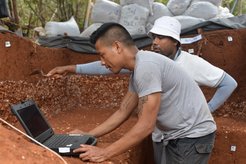
The Zooarchaeology Research Group studies past human-animal interactions, focusing on themes ranging from taphonomy, paleoenvironmental reconstruction, human-subsistence economies and the roles animals played in human cultures. Our group currently works on a wide range of topics, including Late Quaternary extinction and extirpation of megafauna species, the use of fossils and animal remains from archaeological sites to reconstruct past environments, and the subsistence strategies of hunter-gatherer and early pastoralist/agriculturalist societies. We are also interested in the application of zooarchaeological data to contribute to current wildlife conservation efforts, for instance using the archaeological record to trace past biogeographic distributions of different animal taxa and the history of introductions of invasive animal species.
We employ different approaches in our research including traditional zooarchaeological methodologies; geometric, morphometric and biometric analyses; and biomolecular techniques such as zooarchaeology by mass spectrometry. We also closely collaborate with other research groups in the department, including the Stable Isotopes and Archaeoinformatics research groups. Our group is presently involved in numerous field projects around the world both as collaborators (Philippines, Indonesia, Australia, Zambia, and North and Central America) and as project coordinators (Sri Lanka and Armenia).
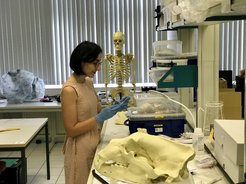
Research Projects
A Tale of Two Archipelagoes: Environment and Human Subsistence Economies in Indonesia and the Philippines during the last 25,000 years
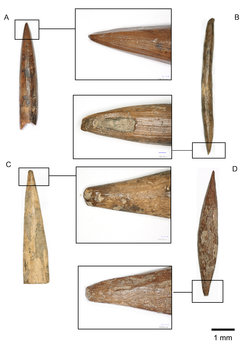
Project members: Noel Amano, Jana Ilgner, Patrick Roberts
The drastic environmental and climatic changes following the Last Glacial Maximum (LGM) greatly impacted human population structures and movements. In Europe, the Middle East and Central Asia, landscape and environmental changes following the LGM are thought to have driven demographic changes and cultural innovations. Perhaps one of the most dramatic landscape changes during the period was the inundation of the Sunda Shelf which resulted in the modern configuration of Island Southeast Asia (ISEA). There are still comparatively few clear indications of the extent that the disappearance of such massive landmass, approximately 75% larger than what exists today, had on human communities. This project aims to contribute to the knowledge of how humans present in ISEA during this period adapted to environmental and climatic fluctuations by studying faunal remains recovered from several cave sites from the Indonesian and Philippine archipelagoes.
Exploring Late Pleistocene Megafaunal Extinctions in North America through Peptide Fingerprinting
Project members: Mariya Antonosyan, Noel Amano, Carli Peters, Nicole Boivin, Patrick Roberts, Ricardo Fernandes
Application of zooarchaeology by mass spectrometry (ZooMS) analysis in North America remains limited and is hindered by a lack of complete reference peptide markers for a number of Late Pleistocene megafaunal taxa. To address this gap, we aim to characterize collagen peptide markers for a significantly expanded number of extant and extinct mammals to amplify the potential of ZooMS in North American contexts. This will result in an improved ability to reconstruct paleoenvironmental conditions and shifts in biodiversity over time, and help assess the impacts of climate change and anthropogenic activities on Late Pleistocene megafaunal extinctions in the continent.
For this project we are collaborating with numerous institutions in North America and Europe, including the Smithsonian National Museum of Natural History, New York State Museum, Charleston Museum, Nevada State Museum, University of Oregon, University of Wyoming and the German Museum of Natural History in Berlin.
Life at the Crossroads: Prehistoric Occupation of the Lesser Caucasus
Project members: Mariya Antonosyan, Noel Amano, Mike Petraglia, Nicole Boivin, Patrick Roberts
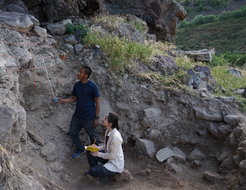
In order to deepen our understanding of human occupation history over the past 30,000 years of this dynamic region, we started the exploration of a number of human settlements and cave sites scattered in Armenia dating back from the Late Iron age all the way back to the Upper Palaeolithic.
Combining zooarchaeological, paleoproteomic and stable isotope approaches, we aim to reconstruct the faunal diversity and environment of the region, human subsistence dynamics, herd management in terms of mobility and seasonality, as well as adaptation to peculiar environmental settings. In particular, we aim to generate a mechanistic understanding of how local populations responded to changing climates (glacial interglacial cycles) and major socio-economic turnovers (establishment of producing lifeways, emergence of metallurgy, birth of states).
Uncovering Human-Megafauna Interactions in the Drowned Caves of the Yucatan Peninsula Mexico
Project members: Óscar R. Solís-Torres, Patrick Roberts, Nicole Boivin, Mike Petraglia Ricardo Fernandes, Noel Amano
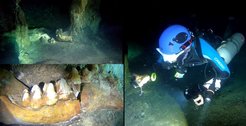
This project aims to apply novel methodologies such as Zooarchaeology by Mass Spectrometry (ZooMS), stable isotope analyses, radiocarbon dating, and taphonomy (including cutmark analysis, site formation studies) to megafaunal remains from the caves in the Cenote Iza, Cenote Papakal, Cenote Ziizha, Cenote Izah, Cenote San Antonio, Taj Mahal Cave, Cenote Sipa and, Cenote Las Palmas, which have not been previously applied on faunal materials from these contexts. Such work has the potential to not only massively contribute to understandings of processes of megafaunal extinction in North America, but also to assess the interactions between our species and megafauna in this region and to build up more detailed records of megafaunal chronology and ecology in a little-studied portion of the Americas.
The application of ZooMS to study Late Quaternary extinctions in Australia
Project members: Carli Peters, Noel Amano, Mike Petraglia, Nicole Boivin
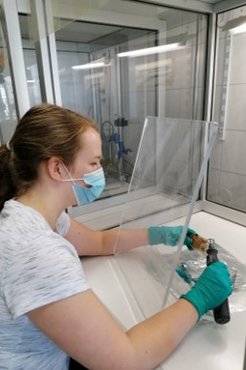
The timing and cause of the Late Pleistocene megafaunal extinctions in Australia and other regions of the world have long been a subject of debate. Some argue that these extinctions were human-induced either directly via predation, or indirectly by the introduction of novel fire regions. Other instead argue that climate change, leading to greater aridity on the Australian continent, caused the extinction of megafauna in Sahul.
One of the main issues in understanding Australian megafauna extinctions is the significant knowledge gaps existing for many species and regions. Data on species biochronology and palaeobiogeography is mostly patchy, with many species only having been reported at a handful of sites. This makes it difficult to test extinction hypotheses, both on a regional and continental scale. One of the main challenges is the large number of highly fragmented, morphologically unidentifiable bones often recovered from Australian faunal assemblages.
This project aims to improve identification rates of fossil fauna at Late Pleistocene sites in Australia by employing ZooMS (Zooarchaeology by Mass Spectrometry). ZooMS is a low-cost, high-throughput proteomics-based approach that can be used to identify fragmented faunal material on the basis of differences in the collagen type I sequences between species. Ultimately, this project aims to gain a better understanding of the spatio-temporal distribution of extinct megafaunal species in Australia, as well as of the contribution of anthropogenic and environmental factors to their extinction.
Human-Animal Interactions in Prehistoric Sri Lanka
Project members: Oshan Wedage, Noel Amano, Mike Petraglia, Nicole Boivin, Patrick Roberts
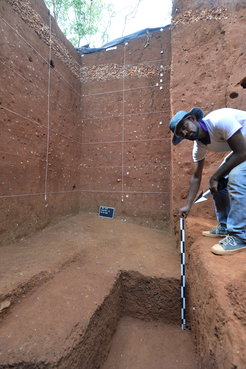
Sri Lanka is home to the earliest fossil evidence for Homo sapiens in South Asia and also provides some of the earliest evidence for human rainforest resource use anywhere in the world. There is also a network of urban settlements in the arid parts of the island that demonstrate sophisticated hydrological technologies to control water.
The investigation of the archaeological record of this country, and the interactions between climate, environment, humans and animals, is a key priority of the Department of Archaeology, Max Planck Institute for the Science of Human History.






